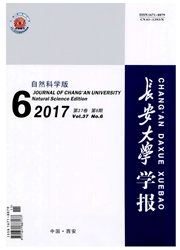

 中文摘要:
中文摘要:
为对比研究荷载作用拉压锚杆的承载特性,进行了缩尺模型试验。在室内模型试验的基础上,对拉压锚杆的应变分布曲线、应力传递过程及破坏过程进行对比分析。结果表明:与拉力型锚杆相比,压力型锚杆的突出优势是锚固段处于三向受压应力状态,这种应力状态不但可以提高锚固体与周围土体之间的黏结应力,而且可以防止锚固体开裂,提高锚杆的耐久性;由于压力型锚杆锚固体与周围土体间的剪应力由孔底向前传递,剪应力分布较拉力型锚杆均匀,且相同荷载下剪切应变小;相对拉力型锚杆,压力型锚杆在复合土体内部应力的传递及分配上更迅速、更合理,整个锚固系统的承载能力更强,如果需要提供相同的承载力,压力型锚杆则可以减少锚固长度,有效降低工程造价,在锚固领域具有广阔的应用前景。
 英文摘要:
英文摘要:
Load bearing features of pressure type and tensile type anchor were studied by the scale model test in laboratory. Based on indoor model test, contrastive analysis was conducted on strain distribution curves, stress transfer processes and destructive processes of tensile and pres sure anchor. The results indicate that compared with tensile anchor, the outstanding advantage of pressure anchor is that the anchoring section is in three-way pressure state. The stress state can not only improve cementation stress between the anchorage body and surrounding soil mass, but also prevent anchorage from cracking and improve durability of anchor. At the same time, be cause shear stress between anchorage of pressure anchor and surrounding soil mass transfers for- ward, the shear stress distributes more uniform than that of tensile anchor. Furthermore, under the same load, there is less shearing strain. Compared with tensile anchor, stress of pressure an chor in composite soil mass transfers and distributes more quickly and reasonably to enhance bear-ing capacity of the whole anchorage system. If it is necessary to provide the same bearing capaci-ty, anchorage length of pressure anchor can be reduced which will reduce construction cost. Therefore, pressure anchor has extensive application prospect in anchorage domain. 10 figs, 16 refs.
 同期刊论文项目
同期刊论文项目
 同项目期刊论文
同项目期刊论文
 期刊信息
期刊信息
